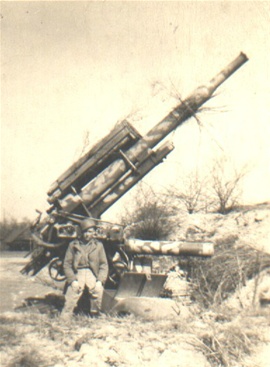 Milt O'Barr and German 88 artillary captured near the Rhine
Milt O'Barr and German 88 artillary captured near the Rhine
FROM OLIVE TREES NEAR VENAFRO. WHERE ANCIENT TREES GROW ROW ON ROW. THE SURROUNDING MOUNTAINS CAPPED WITH SNOW. HOW
MANY DIED THERE? WE'LL NEVER KNOW.
THEY TRADED THE ENEMY SHELL FOR SHELL. AND TOOK THE PLACE WHERE COMRADES FELL. AMIDST THE WHISTLING BURSTING HELL. HOW MANY DIED THERE, WE'LL NEVER KNOW.
THEY ARE ALL BRAVE, BOTH OLD AND YOUNG. ALL ARE
HEROES, SOME UNSUNG. THEY GAVE THEIR LIVES WITHOUT REGRET. THESE MEN, THESE MEN, WE'LL NEVER FORGET.
(written in a foxhole by William Gentry, Company A 85th
Engineers)
The Engineers were essential to victory in the war
against Germany. Without them, the allied armies would be stuck on the banks of countless rivers as the retreating enemy destroyed the bridges required for passage.
One of the many duties of
the Engineers was to provide the means for the front line soldiers to cross rivers in pursuit of the enemy. This duty often placed them at the front of the front lines. So much so that it was said in jest, "The Engineers built the bridges over which the enemy
retreated." The significance of the Engineers is reflected in a line of song they sung during WWII: "We clear the way for the others to come in."
By the spring of 1945, the Engineers represented
8% of the Armed Forces, some 500,000 in uniform. "Essayons" was their motto, which was loosely translated as "Let us succeed." That success was dependent upon the leadership of men such as the Chief of Engineers Maj. Gen. Eugene Raybold, who was the commanding
officer from 1941-1945. It was his task to lead the Corp in implementing the four major duties assigned to it: to clear and build; to survey and map; to supply water and electricity; and to develop materials and technology for camouflage.
Carrying out those duties was complicated by the fact that WWII was taking place at a time in history when warfare was transitioning from horses and hand tools to mechanization and rapidly advancing technology.
It was no small challenge that faced the Allied Armies during WWII. Imperiling that task was the fact that they were going to battle against the most technologically advanced military of that era. The Allied victory in WWII was seemingly against all odds.
But helping to even the odds were the men who wore the castle on their lapel. Their contribution to victory was immeasurable. They were some of the greatest of the "greatest generation".
These
were the men of the 85th Engineers. Their challenge was twofold: to aid in the defeat of a ruthless enemy, while at the same time performing hazardous duty on rivers with swift and deadly currents. In fact, the 85th would lose more men to the rivers than it
did to the enemy. But for them there was no challenge that would deter them from victory. There was no obstacle they couldn't overcome. There was no muddy Italian road they couldn't traverse. There was no snow in France deep enough to slow their march. There
was no German artillery intense enough to keep them from bridging their way into the heart of the German Fatherland. There was indeed, as the motto of the 85th states: "no river too swift."
What follows in this web sight is an extensive history and photo diary that records the journey of the 85th Engineers during WWII. For those who served in the 85th, it is hoped that this material will be for you an enjoyable recounting
of your past heroism. For those who didn't serve in the 85th it is hoped that this material will enable you to recognize that we have among us heroes whose gift to us is freedom. May we never take it, nor them, for granted.
Special recognition is given to Tech Sgt. John Citera of H&S Company, Tech 5 Arthur DeAngelo of H&S Company, Tech 5 William W. Gentry, Tech 5 Sam J. Hopkins, Cpl. Mel H. O'Barr, and to Tech 5 Milt L. O'Barr, Company 'A' 85th,
whose WWII photo albums provided the images found in this presentation.
The historical information contained on this site comes from several sources. Some
of the technical data is from the 2 volume set, THE TECHNICAL SERVICES: THE CORP OF ENGINEERS. Most of the historical information is from the 85th's original records archived at NARA, and from the 85th's records at the National Personnel Records Center. Personal
interviews conducted with members of the 85th are the source for the information in the "Memoirs" section. The photos are from the personal photo albums of members of the 85th engineers.
"We are the Engineers,
the roughest, toughest outfit in the Army.
Free fighting Engineers,
we like to fight, we think it's fun.
And we can really handle a gun.
We make the way for the others to come in.
And when we meet the enemy we hit him on the chin.
We are the Engineers,
The roughest, toughest
outfit in the army."
Through out the web site you will find bullet points indicating significant WWII events that occurred concurrent with the history of the 85th. Every effort has been made
to maintain historical accuracy on this web site.
Rod O'Barr, Webmaster